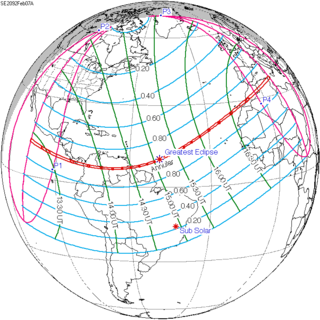
Back خورشیدگرفتگی ۷ فوریه ۲۰۹۲ Persian Eclissi solare del 7 febbraio 2092 Italian 2092년 2월 7일 일식 Korean سورج گرہن 7 فروری 2092ء Urdu 2092年2月7日日食 Chinese
| Solar eclipse of February 7, 2092 | |
|---|---|
| Type of eclipse | |
| Nature | Annular |
| Gamma | 0.4322 |
| Magnitude | 0.984 |
| Maximum eclipse | |
| Duration | 108 s (1 min 48 s) |
| Coordinates | 9°54′N 48°42′W / 9.9°N 48.7°W |
| Max. width of band | 62 km (39 mi) |
| Times (UTC) | |
| Greatest eclipse | 15:10:20 |
| References | |
| Saros | 132 (50 of 71) |
| Catalog # (SE5000) | 9714 |
An annular solar eclipse will occur at the Moon's descending node of orbit on Thursday, February 7, 2092,[1] with a magnitude of 0.984. A solar eclipse occurs when the Moon passes between Earth and the Sun, thereby totally or partly obscuring the image of the Sun for a viewer on Earth. An annular solar eclipse occurs when the Moon's apparent diameter is smaller than the Sun's, blocking most of the Sun's light and causing the Sun to look like an annulus (ring). An annular eclipse appears as a partial eclipse over a region of the Earth thousands of kilometres wide. Occurring about 6.25 days before perigee (on February 2, 2092, at 9:00 UTC), the Moon's apparent diameter will be larger.[2]
The path of annularity will be visible from parts of Panama, Colombia, Venezuela, Guyana, the Canary Islands, Morocco, Algeria, and Tunisia. A partial solar eclipse will also be visible for parts of North America, Central America, the Caribbean, northern South America, West Africa, Northwest Africa, and Western Europe.
- ^ "February 7, 2092 Annular Solar Eclipse". timeanddate. Retrieved 24 August 2024.
- ^ "Moon Distances for London, United Kingdom, England". timeanddate. Retrieved 24 August 2024.
